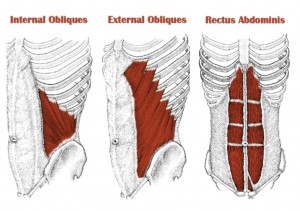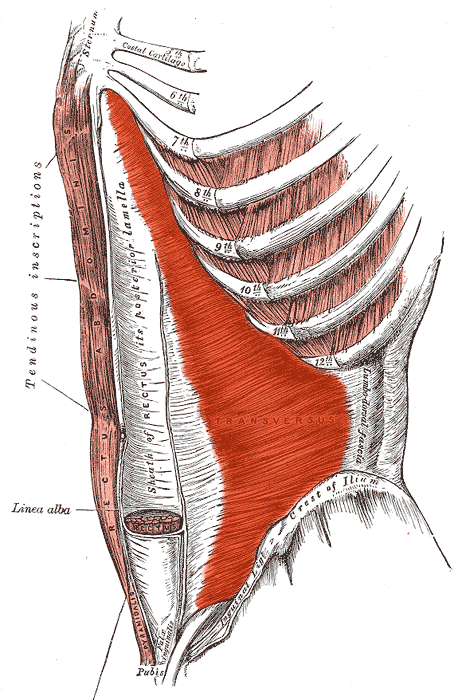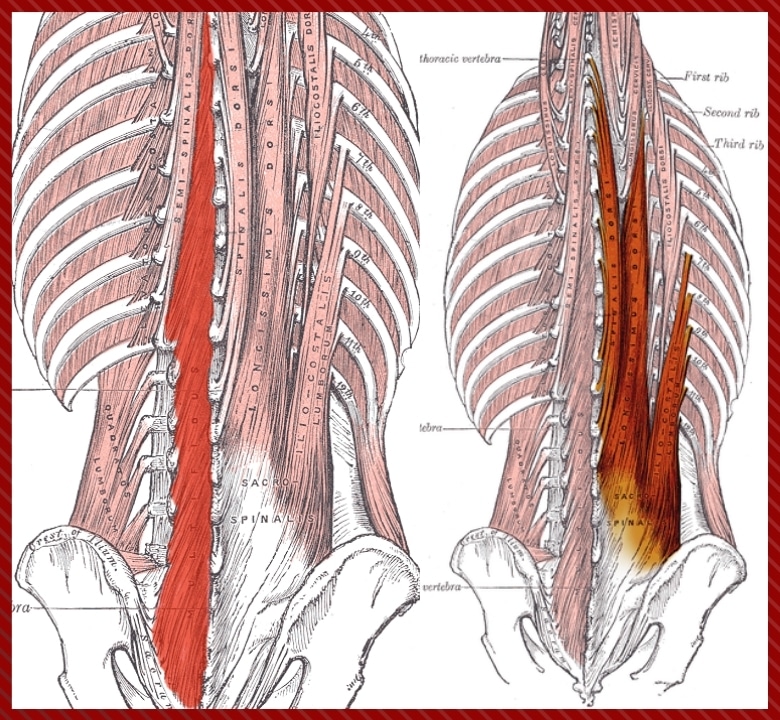Some links in this article are affiliate links, which means I earn from qualifying purchases.
I started my lifting career with the big 3 movements: deadlifts, squats, and bench press.
Slowly, I noticed my strength gains increasing but my abs were not developing. I would definitely feel my abs sore on squat days but do they actually work during these movements?
So I started doing some research on this subject. Many lifters have the belief that both squats and deadlifts work the core. But, what is the science based answer?
So, do squats work your core and your abs? Squats strengthen your core and activate your abs. The primary muscle activator is the erector spinae part of the posterior core. This muscle runs down the sides of the spine. To get the most from your squats, use different types and heavy barbell weights. For aesthetic purposes, your workout should also include other core ab exercises.
Let’s take a look at the different parts of the core, and try to understand whether you can skip training abs at the end of your workout.
What Is The Core?
To understand the answer to the question of whether squatting makes our core stronger, we must first make a brief anatomical analysis of our core.
Our middle section consists of a cylindrical trunk around the mid section. What many people don't think of when they see the core is the posterior (back) section of the abdomen.
In reality, the core has a front and a back section.

Rectus Abdominis
Rectus abdominis - the so-called "plates". Its functions include pelvic flexion, protection of internal organs, prevention of pelvic rotation, creation of intra-abdominal pressure, and maintaining proper posture in the waist.
It is important to mention that this is a muscle - it is activated. And works simultaneously along its entire length, is anatomically and motorically. There is no division between the upper and lower abdomen.
So, there are no exercises that load a certain area of the rectus abdominis - it is a whole.
External Obliques
These are located symmetrically on both sides of the rectus abdominis. They serve to tilt and rotate the body to the side.
In the opposite direction, is the left muscle rotates to the right and the right - to the left.
Internal Obliques
Internal oblique muscles. Also located on both sides of the "plates". Those muscles have the role of rotating the body sideways.
With the difference that the left muscle moves to the left and the right to the right.
Transverse Abdominis
This is the deepest of all the abdominal muscles.
It handles maintaining intra-abdominal pressure and a stable waist position.
This is essential for preventing injuries in this area. This muscle is the natural "belt" for lifting weights.
The TVA muscle helps keep your stomach in and many bodybuilders use this exercise to shrink the waist.

Erector Spinae
The erector spinae is the main muscle groups in the posterior part of the core.
It is a group of muscles and tendons that runs from the base of the spine to the skull. They run across the vertebrae on both the left and right side of the spine.

Lumbar Multifidus
The lumbar multifidus muscle is another part of the posterior part of the core. Similar to the erector spinae, it runs across the spine and helps stabilize your back.
The muscle is unequal and gets bigger in the lumbar region. So, during a squat the muscle you feel at the bottom of the movement is most likely the deep multifudus.
What Are Squats?
The squat is a fundamental muscle-reinforcing development, essential for all gains.
We stand up straight with our legs shoulder-width separated, look forward, squat down. The key points to remember are the importance of keeping your torso upright during the movement.
In addition, leaning forward during squat sis quite common. This mistake can cause some lifters discomfort in the lower back.
Once you're in the lower position, you flex your glutes to push the weight upwards back to the starting position.
The Role Of The Core And Abs During Squats
You are more likely than not felt tired in the mid-region after doing a long and extreme arrangement of squats.
When performing squats, our center and midsection are under consistent pressure. At the point when we go from an upstanding situation to a squat position.
Before descent, you should breathe in as much air as possible and flex your core. The proper breathing and bracing technique will dramatically improve your squat progression.
The main role of the abs during squats is similar to a weight lifting belt. Your abs help provide a wall to push against during bracing. The stronger the wall, the harder the brace and the more you can squat.
Do Squats Work The Core? Science Based Answer
Now that we know how squats and your abs work together, what does the science say?
Well, I went through hours of research and several studies to determine the exact answer.
Squats Activate The Erector Spinae
The first study we will go over is done by the van den Tilaar group. They compared the prone bridge and back squats done to 6 max repetitions.
For each participant, they used 20% of their bodyweight as the barbell squat weight. They tested the EMG activity of the rectus abdominis, external oblique and erector spinae.
In comparison to the prone bridge, they found the back squat had more erector spinae muscle activity.
Overhead Squats Are Better For The Anterior Core
In a study by Aspe et al, they compared the back squat and the overhead squat.
They measured muscle activity during 60, 75, and 90% 3 repetition maximum squats.
Based on their results, they concluded that the overhead squat is more effective in activating the rectus abdominis and external oblique than back squats.
This was especially true during the descending phase of the squat (eccentric phase).
Back Squats Are Better For The Posterior Core
In the same study by Aspe et al, they found back squats are way more effective in activating the posterior trunk.
Specifically, back squats activate the erector spinae more than overhead squats while ascending (concentric phase).
Barbell Squats Activate Better Than Smith Squats
Both Fletcher et al and Saeterbakken et al wanted to measure the core activation during different lower body movements.
The both found barbell squats to engage the core more than Smith machine squats. Further, they found that activation of the core can be further increased by destabilizing the barbell. Specifically, you can use a Tendo-destabilizing bar.
Use Verbal Cues To Help With Core Activation
Bressel et al set out to determine the effect of verbal cues, load, and surface stability on core activation during the squat.
They allowed 12 males to perform the squat during various conditions.
Similar to the previous study, the peak erector spinae activity occurred during 75% 1-RM weight. This was the highest activation than any of the other conditions.
However, they found that activation of other anterior core muscles (rectus abdominis, internal/external obliques, and TVA) increased by 39–167% with verbal cues. So, if you have a partner during squats, get them to tell you consciously about flexing your core muscles.
You can also mentally remind yourself before every squat rep which should have the same effect.
Squatting At 50% Of 1-RM Improves Core Activation
In a fantastic review of the barbell squat and core activation, Clark et al found a certain weight improves ab use.
They found that different stances and grip width had no effect on core activation. Instead, the main conclusion of their review was an increase in external loads increases core activation.
Specifically, any squat weight greater that 50% of 1RM will further activate your core and abs.
Incorporate Ab Training With Squats
So the question becomes should you train abs if you squat?
Will you be able to develop your core enough with just squats? From a training perspective, a workout should incorporate variety and different intensities. In addition, a workout should be efficient.
To get the most out of your core training, using different exercises will target your abs in other ways. Here are a few ab exercises to incorporate with your squats to fully develop your core and maximize gains.
Rope Crunch
The rope crunch will directly activate your rectus abdominis. This exercise is quite effective in ab activation but can be done wrongly very easily.
Most people will improperly bend their trunk or use their hands too much.
Ab Roll Outs
The Ab Wheel is a great tool to enhance your core workouts.
You can start from beginner friendly workouts to more advanced progressions. The rectus abdominis and TVA muscle will be activated with this exercise.
Hanging Leg Raises
For a bodyweight exercise, hanging leg raises are very effective in activating the rectus abdominis. In addition, if you learn to posterior tilt at the beginning of the movement, the TVA will further get activated.
Bicycle Crunches
To really work your obliques, bicycle crunches are great.
The twisting action in this exercise helps target those stubborn side core muscles.
Frequently Asked Questions
Do Front Squats Work Abs?
Front squats work and strengthen your abs during the movement. These type of squats tend to work and activate the front part of your trunk more than the back. So, your rectus abdominis and obliques will be activated during the front squat.
How Do You Engage Your Core When doing squats?
The most important component of your squat will be how you breathe and brace. During the beginning of the movement, the core is engaged to help keep your torso upright. A good mental cue to think about is pretending to go under water. Take a deep breath and flex your abs before squatting down.
Can You Get Abs By Doing Squats?
Abs are a muscle that needs development. Although squats engage your core, doing different ab exercises at various intensities will target angles. However, no matter how much core and ab work you do, they won't show until you're at a low enough level of body fat.
How Do Squats Help Your Abs?
Squats activate your posterior core trunk as well as your rectus abdominis during certain types. They will help develop axial loading strength and work your core. Think of it as keeping your torso upright to prevent from falling over. Core strength is very important during squats to prevent the weight from crushing you.
Final Thoughts
Well, I hope this article has been informative and accurate in answering the question of do squats work your core.
These studies show how different squat types can target different parts of your core. Do squats work your abs? The answer is yes in many different ways but be sure to make them part of a complete ab workout.
References
Lander JE, Simonton RL, Giacobbe JK. The effectiveness of weight-belts during the squat exercise. Med Sci Sports Exerc. 1990 Feb;22(1):117-26. PMID: 2304406.
Barbosa AC, Martins FM, Silva AF, Coelho AC, Intelangelo L, Vieira ER. Activity of Lower Limb Muscles During Squat With and Without Abdominal Drawing-in and Pilates Breathing. J Strength Cond Res. 2017 Nov;31(11):3018-3023. doi: 10.1519/JSC.0000000000001877. PMID: 29068863.
Linde LD, Archibald J, Lampert EC, Srbely JZ. The Effect of Abdominal Muscle Activation Techniques on Trunk and Lower Limb Mechanics During the Single-Leg Squat Task in Females. J Sport Rehabil. 2018 Sep 1;27(5):438-444. doi: 10.1123/jsr.2016-0038. Epub 2018 Jul 20. PMID: 28714764.
Bressel E, Willardson JM, Thompson B, Fontana FE. Effect of instruction, surface stability, and load intensity on trunk muscle activity. J Electromyogr Kinesiol. 2009 Dec;19(6):e500-4. doi: 10.1016/j.jelekin.2008.10.006. Epub 2008 Dec 2. PMID: 19054687.
Willardson JM, Fontana FE, Bressel E. Effect of surface stability on core muscle activity for dynamic resistance exercises. Int J Sports Physiol Perform. 2009 Mar;4(1):97-109. doi: 10.1123/ijspp.4.1.97. PMID: 19417231.
Aspe RR, Swinton PA. Electromyographic and kinetic comparison of the back squat and overhead squat. J Strength Cond Res. 2014 Oct;28(10):2827-36. doi: 10.1519/JSC.0000000000000462. PMID: 24662228.
van den Tillaar, R., & Saeterbakken, A. H. (2018). Comparison of Core Muscle Activation between a Prone Bridge and 6-RM Back Squats. Journal of human kinetics, 62, 43–53. https://doi.org/10.1515/hukin-2017-0176
Oliva-Lozano, J. M., & Muyor, J. M. (2020). Core Muscle Activity During Physical Fitness Exercises: A Systematic Review. International journal of environmental research and public health, 17(12), 4306. https://doi.org/10.3390/ijerph17124306
DISCLAIMER: This article is for intended for educational purposes only and not as an individualized exercise prescription, therefore no one can be held liable in the occurrence of injuries, damages or monetary losses as a result of the information.





